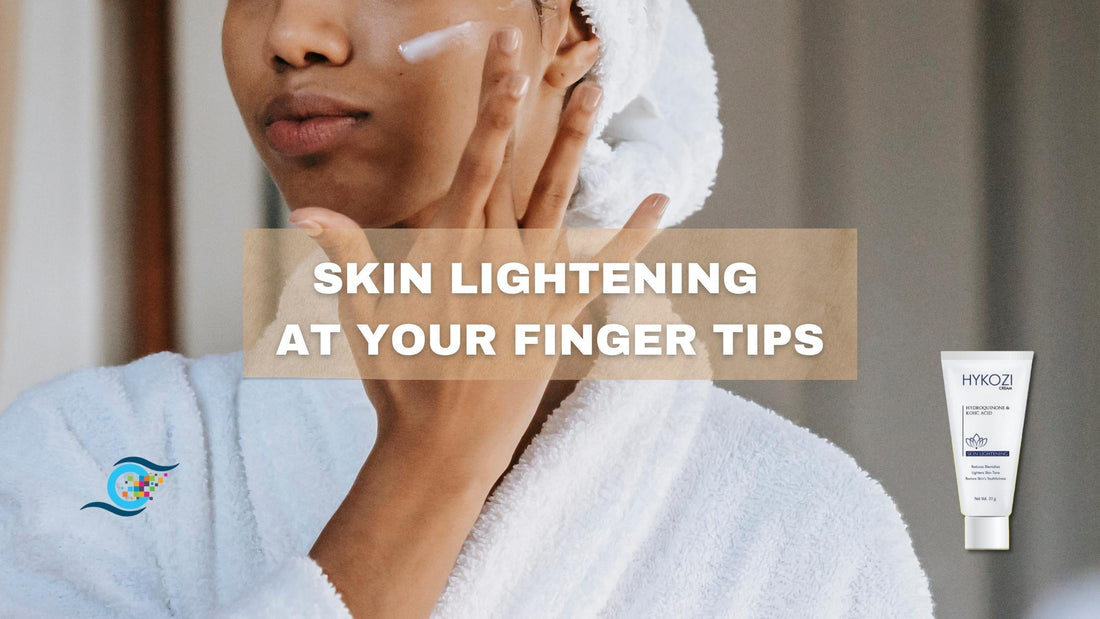
The science behind skin brightening products. Skin lightening treatment at your fingertips.
Share
Sskin lightening treatment or Skin brightening is not just for cosmetic purposes but also dermatological reasons. It is one of the most important indications why a dermatologist or a skin specialist is consulted.
What is skin lightening treatment and why is it so important?
Skin Lightening is the process of reducing dark spots of the skin or the uneven hyperpigmented areas of the skin caused because of hyperpigmentary disorders such as melasma, café au lait spots, solar lentigo, etc.
With the advancement in dermatological & cosmetology research backed by molecular sciences and the latest technologies lot of modalities have been developed to achieve skin lightening. These include laser therapies such as Resurfx, minimally invasive dermatology procedures like dermabrasion, micro-needling, etc. The most common and widely used approaches are oral SkinCeuticals and topical application of skin preparations that contain skin lightening agents like Hydroquinone, Kojic Acid, Alpha Arbutin, Liquorice extract, Azelaic Acid, Lactic Acid, Glycolic acid, and many other specialized formulations.
Hykozi skin lightening treatment and Brightening Formula for Hyperpigmented Skin.
Hykozi is a unique skin lightening treatment & Skin Brightening formula is developed by dermatologists for relief from skin hyperpigmentation, melasma, post inflammatory hyperpigmentation, and other hyperpigmentary conditions.
Hykozi Ingredients:
Hydroquinone 2%, Kojic Acid 2%, Alpha Arbutin 1%, Glycolic acid 0,2% Lactic acid 0.2% Liquorice Extract 1%
How to use HYKOZI skin lightening formula:
Please wash the face and hands before using cream.
Pat dry the face gently with a soft towel or cloth.
Take a drop size or a size of a small pea on the fingertips,
First, apply to the hyperpigmented spots and then to the rest of the areas surrounding them.
Apply gently in a circular motion for even distribution.
One fingertip of cream is enough for the whole face.
First-time users wait and watch for any irritation on the skin. if that happens wash it with water.
If no irritation is observed then leave the cream overnight and wash it in the morning.
For best optimal results it is advisable to use sunscreen whenever going outdoors or in sun exposure.
For lips lightening, there is a different Hykozi lip balm.
Precautions:
Do not rub.
Keep it away from eyes and lips and mucosal membranes.
Do not mix the application with any other skin lightening cream especially benzoyl peroxide and salicylic acid.
It’s best to be used as a stand-alone product.
What is the science behind skin pigmentation?
Skin is the largest organ in the body. Its functions include protection, sensory, endocrine, excretion, movement, immunity, thermoregulation, and homeostasis. The pigment imparting color to the skin is called melanin, which is produced in melanosomes in specialized cells known as melanocytes within the dermis. Everyone has a more or less similar number of melanocytes in the deeper layer of our skin. The skin color depends upon the active number of the melanocytes. Eumelanin is darker melanin while pheomelanin is lighter melanin.
What are the steps of skin pigmentation or melanogenesis?
The process of production of melanin in the skin is known as melanogenesis. UV rays from the sun alter the DNA of Keratinocytes in the dermis, which activates the Melanocytes via a series of complex steps mediated by enzymes and cofactors. These melanosomes are then transported from Melanocytes to Keratinocytes and then melanin is released to the epidermis. This imparts color to the skin. The function of melanin is to protect the skin from UV rays, that cause free radical oxidative damage to the DNA. The key enzymes & mediators involved in melanogenesis are Tyrosinase, Phenylalanine hydroxylase (PAH), Tyrosinase hydroxylase isoenzyme 1 (TH-I), DOPA-oxidase, and Tyrosinase-related proteins (TRP-1,2)
How do Skin Lightening products work?
Skin Lightening products are also called skin-whiteners, brighteners, or bleach creams. They try to even lessen skin coloration due to the formation of excessive melanin.
They downregulate, inhibit or modulate one or more steps involved in melanogenesis such as Protection from UV Rays, Inhibit keratinocyte mediator binding, block the activation of Tyrosinase, Inhibition of Enzymes involved, blocking the formation of Melanosome, blocking the Transfer from Melanocyte to keratinocytes, inhibiting protein expression.
Mechanism of actions Skin-Lightening agents:
- Hydroquinone inhibits tyrosinase activity, cellular metabolism, affect both DNA and RNA syntheses and melanin
- Kojic Acid/Kojic acid tripeptides inhibit the catecholase activity of tyrosinase.
- Arbutin/deoxyarbutin, inhibits tyrosinase, tyrosine hydroxylase, DOPA-oxidase, and melanin production.
- α-Hydroxy acid-like Glycolic acid and lactic acid inhibit Tyrosinase activity & melanin formation.
- Licorice extract Glabiridin Glabrene and isoliquiritigenin inhibit both mono- and diphenolase tyrosinase activities
- Azelaic acid limits melanin creation by inhibiting tyrosinase.
- Aloesin Inhibits tyrosinase, tyrosine hydroxylase, and DOPA oxidase in synergy with arbutin
- Resveratrol reduces MITF and tyrosinase promoter activities.
- Soybean inhibits protease-activated receptor 2 cleavage, affects cytoskeletal and cell surface organization, and reduces keratinocyte phagocytosis.
- Niacinamide inhibits the catalytic activity of tyrosinase on melanogenesis and inhibits melanosome transfer.
- Retinoic acid inhibits tyrosinase/TRP-1 protein expression and melanin synthesis.
- Vitamin C (magnesium ascorbyl phosphate) Suppresses Tyrosinase induced melanin formation in melanocytes.
- Octadecenedioic acid reduces tyrosinase mRNA and protein expression inhibiting melanogenesis
- Serine protease inhibitors inhibit Melanosome transfer.
- Phyllanthus Emblica (fruit) extract, has antioxidant activity, chelating properties, and inhibit MMP-1 and MMP-3.
- Glutathione, directly and indirectly, inhibits tyrosinase enzyme and favors pheomelanin over eumelanin production.
- Several other ingredients like Evening prime rose oil, Gold, rose seed oil, Lemongrass oil, Pumpkin seed oil, Orange peel oil, Vit E, Salicylic acid, Squalene, Shea butter, Lecithin, Cocoa butter, Aloe vera, Mulberry extract, Bio white, Raguage, Pentavitine along with many others help in the process of skin lightening by different mechanisms ( not all skin lightening agents are included in this article)
References:
-
Cabanes, J., Chazarra, S. and Garcia-Carmona, F. Kojic acid, a cosmetic skin whitening agent, is a slow-binding inhibitor of catecholase activity of tyrosinase.J.Pharm.Pharmacol.46(12), 982–985(1994).
-
Chakraborty, A.K., Funasaka, Y., Komoto, M. and Ichihashi, M. Effect of arbutin on melanogenic proteins in human melanocytes.Pigment Cell Res.11(4), 206–212 (1998).
-
Chawla, S., DeLong, M.A., Visscher, M.O., Wickett, R.R., Manga, P. and Boissy, R.E.Mechanism of tyrosinase inhibition by deoxy Arbutin and its second-generation derivatives. Br. J. Dermatol.159(6), 1267–1274 (2008).
-
Kim, Y.J. and Uyama, H. Tyrosinase inhibitors from natural and synthetic sources: structure, inhibition mechanism, and perspective for the future. Cell. Mol. Life Sci.62(15), 1707–1723 (2005).
-
Maeda, K. and Fukuda, M. Arbutin: mechanism of its depigmenting action in human melanocyte culture.J. Pharmacol.Exp. Ther.276(2), 765–769 (1996).
-
Nerya, O., Vaya, J., Musa, R., Izrael, S., Ben-Arie, R., and Tamir, S. Glabrene and isoliquiritigenin as tyrosinase inhibitors from licorice roots.J. Agric. Food. Chem.51(5), 1201–1207 (2003).
-
Penney, K.B., Smith, C.J., and Allen, J.C. Depigmenting action of hydroquinone depend on disruption of fundamental cell processes.J. Invest. Dermatol.82(4), 308–310 (1984).
-
Usuki, A., Ohashi, A., Sato, H., Ochiai, Y.,Ichihashi, M. and Funasaka, Y. The inhibitory effect of glycolic acid and lactic acid on melanin synthesis in melanoma cells. Exp. Dermatol.12 (Suppl 2), 43–50 (2003)
-
Verallo-Rowell, V.M., Verallo, V., Graupe, K., Lopez-Villafuerte, L. and Garcia-Lopez, M. Double-blind comparison of azelaic acid and hydroquinone in the treatment of melasma. Acta Derm. Venereol. Suppl. (Stockh)143, 58–61 (1989).
Disclaimer:
Not all skin care products are suitable for everyone. Always make sure to ask a specialist what is best for your skin.
The content of this article is for information and educational purposes only. It is not intended to diagnose, cure or suggest a medical treatment. Readers are advised to check with a dermatologist before using any skincare preparation.





